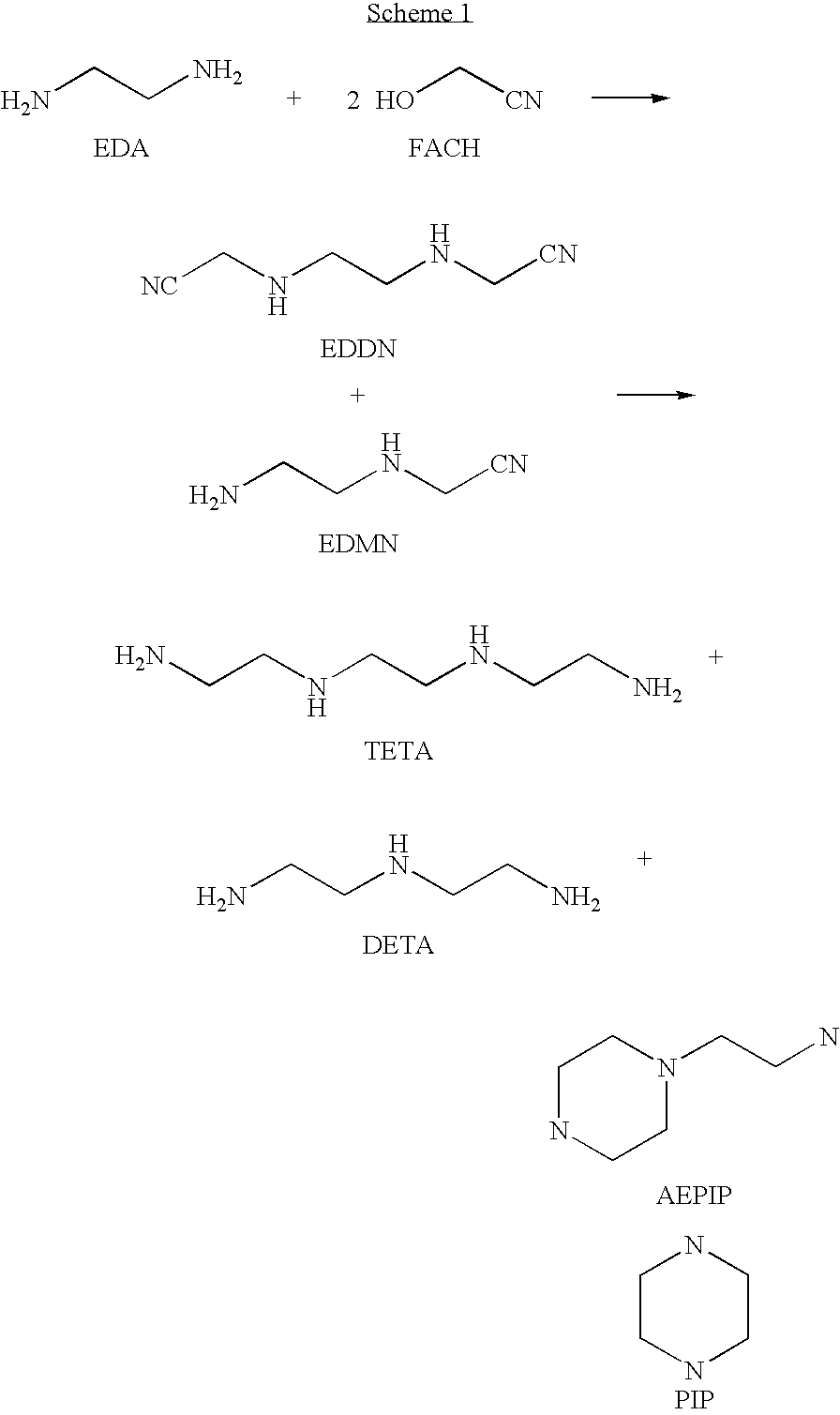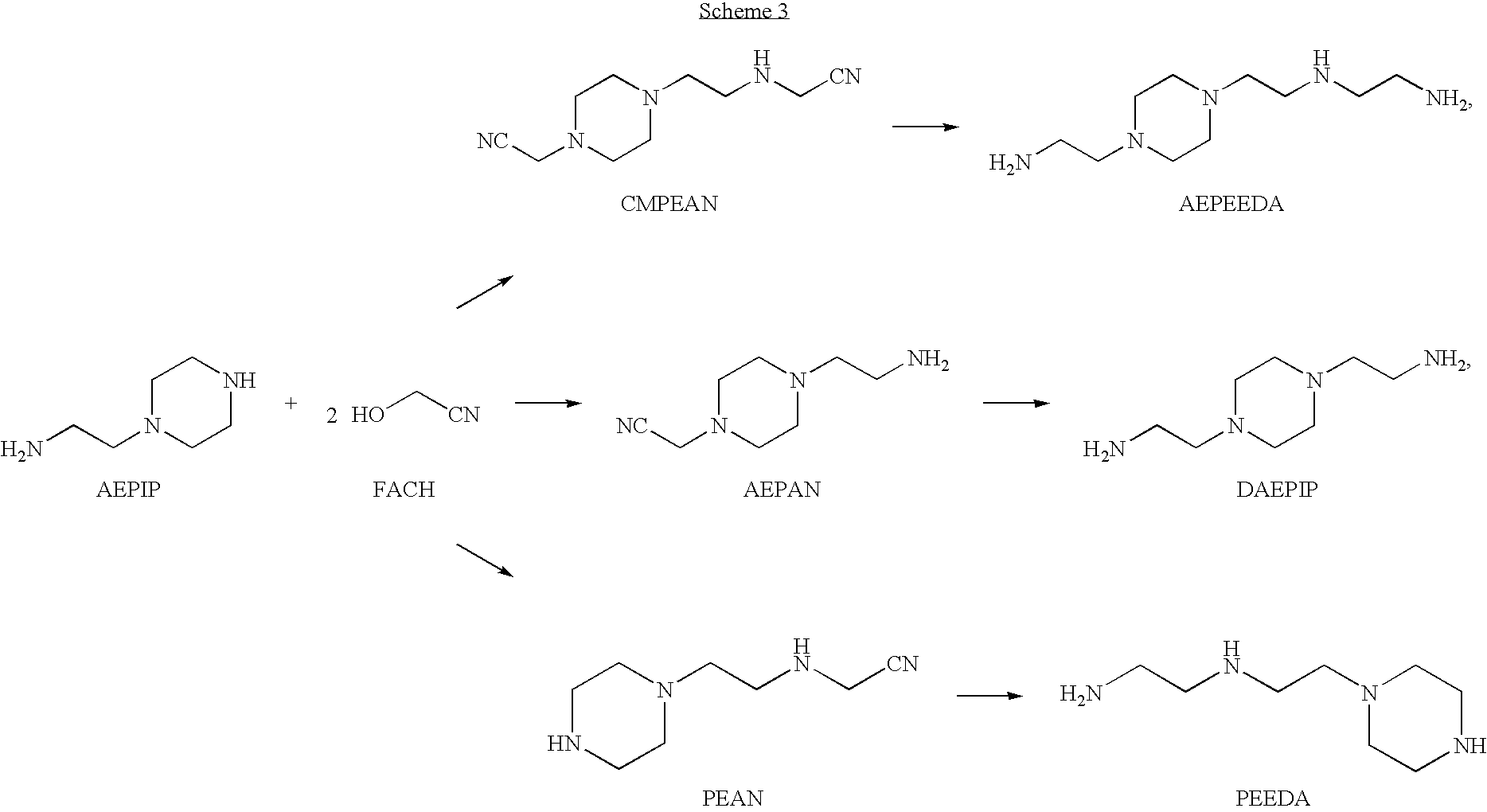Method for producing TETA by means of EDDN
- Summary
- Abstract
- Description
- Claims
- Application Information
AI Technical Summary
Benefits of technology
Problems solved by technology
Method used
Image
Examples
example 1
[0132]FACH is prepared according to variant a) of the general method.
Ethylenediaminediacetonitrile
[0133]536.5 g (4 mol) of FACH (42.5%) are placed in a 2 l reaction vessel and, while cooling in ice, 132 g (2.2 mol) of ethylenediamine are added dropwise at a temperature of not more than 35° C. over a period of 2 hours. The reaction mixture changes color from slightly yellowish via orange to brown. After stirring for a further short time, the free hydrocyanic acid is removed by stripping with nitrogen (Volhard titration). According to Liebig titration, a conversion of FACH of 97.2% is obtained.
[0134]a) The product obtained is hydrogenated in a semibatch process. Here, 3.25 g of a Cr-doped Raney cobalt catalyst and 15 ml of THF are placed in a 270 ml autoclave. The autoclave is heated to 120° C. and pressurized with hydrogen to a total pressure of 100 bar. A mixture composed of 13.8 g of the crude EDDN solution, 13.8 g of an internal standard...
example 2
[0137]FACH is prepared according to variant b) of the general method.
Ethylenediaminediacetonitrile
[0138]132 g (2.2 mol) of EDA are placed in a 2 l reaction vessel and, while cooling in ice, 511.2 g (4 mol) of FACH (44.6%) are added dropwise at a temperature of not more than 30° C. over a period of 2 hours. After stirring for another 4.5 hours, the slightly yellowish solution is dispensed. The conversion of FACH according to Liebig titration is 99.2%. The reaction mixture comprises 0.11% of free hydrocyanic acid (determined by Volhard titration). Titration indicates an EDDN yield of 91.7% based on FACH used. EDMN cannot be determined by titration. On the assumption that EDMN is formed from reacted ethylenediamine which does not react to form EDDN, the total amino nitrile yield is 95.7% and the yield of EDMN is thus 4%.
[0139]a) The product obtained is hydrogenated in a semibatch process. Here, 3.25 g of a Cr-doped Raney cobalt catalyst and 1...
example 3
[0143]FACH is prepared according to variant b) of the general method.
Ethylenediaminediacetonitrile
[0144]132 g (2.2 mol) of EDA are placed in a 2 l reaction vessel and, while cooling in ice, 340.8 g (4 mol) of FACH (67%) are added dropwise at a temperature of not more than 30° C. over a period of about 2 hours. After stirring for another 3 hours, the yellowish solution is dispensed. The conversion of FACH according to Liebig titration is 99.5%. The reaction mixture comprises 0.08% of free hydrocyanic acid (determined by Volhard titration). Titration indicates an EDDN yield of 82.9% based on FACH used. EDMN cannot be determined by titration. On the assumption that EDMN is formed from reacted ethylenediamine which does not react to form EDDN, the total amino nitrile yield is 90.5% and the yield of EDMN is thus 8%.
[0145]a) The product obtained is hydrogenated in a semibatch process. Here, 3.25 g of a Cr-doped Raney cobalt catalyst and 15 ml of...
PUM
| Property | Measurement | Unit |
|---|---|---|
| Temperature | aaaaa | aaaaa |
| Temperature | aaaaa | aaaaa |
| Temperature | aaaaa | aaaaa |
Abstract
Description
Claims
Application Information
 Login to View More
Login to View More - R&D
- Intellectual Property
- Life Sciences
- Materials
- Tech Scout
- Unparalleled Data Quality
- Higher Quality Content
- 60% Fewer Hallucinations
Browse by: Latest US Patents, China's latest patents, Technical Efficacy Thesaurus, Application Domain, Technology Topic, Popular Technical Reports.
© 2025 PatSnap. All rights reserved.Legal|Privacy policy|Modern Slavery Act Transparency Statement|Sitemap|About US| Contact US: help@patsnap.com



